Mulholland Monuments
Mulholland Memorial Fountain
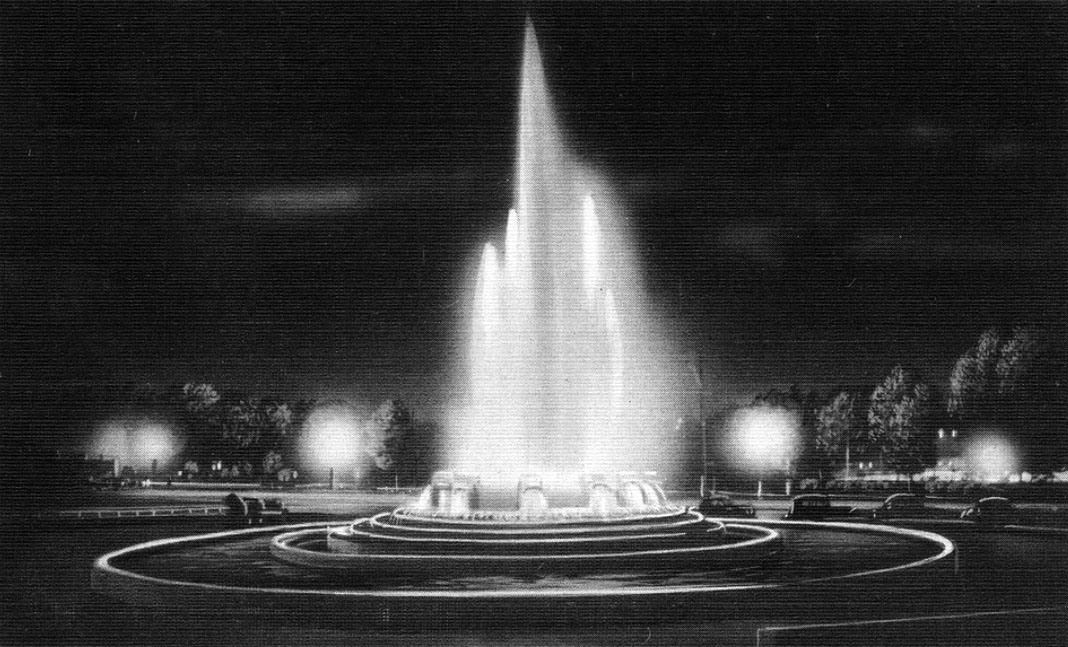 |
|
| (ca. 1940)**^ – Postcard view showing the Mulholland Memorial Fountain located on the corner of Los Feliz Boulevard and Riverside Drive. |
Historical Notes At the corner of Riverside Drive and Los Feliz Boulevard in Los Feliz, spitting distance from the Los Angeles River, you’ll find a shrine to the “Father” of L.A.’s water system, William Mulholland – built approximately on the site where Mulholland once lived in a cabin, worked as a water laborer (technically a ditch-tender) and taught himself to be a civil engineer. Designed by Walter S. Claberg, the William Mulholland Memorial Fountain was originally dedicated in 1940, five years after the former water supervisor’s death, thanks largely to contributions and donations from local schoolchildren. |
.jpg) |
|
| (1940)* - View of the Mulholland Memorial Fountain during the day shortly after it was dedicated. The fountain was designed by Walter S. Clayberg. |
Groundbreaking Ceremony
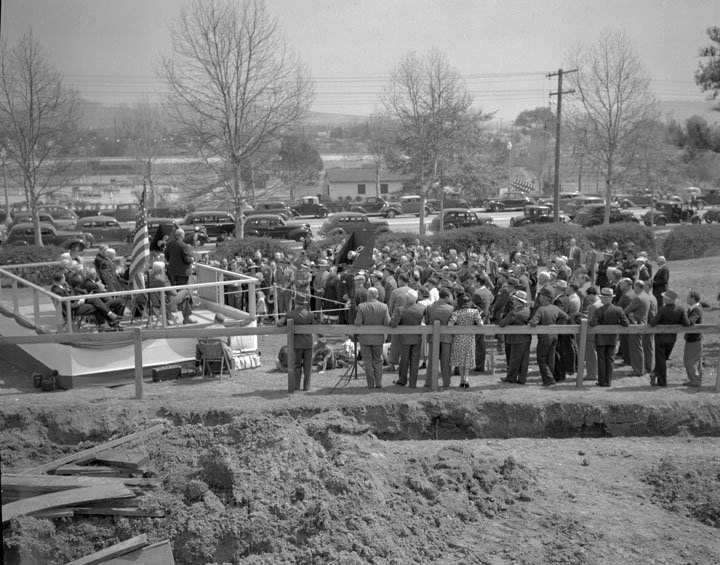 |
|
| (1940)* - History was made and relived as persons prominent in the city's life gathered on Riverside Drive and Los Feliz Boulevard the morning of March 30, 1940 to recount the deeds of William Mulholland and to break ground for a fountain memorial. |
LADWP Historic Archive
April 1940 – Groundbreaking Ceremonies, marking actual start of construction on the memorial fountain being erected in honor of William Mulholland, were held March 30th at Riverside Drive and Los Feliz Blvd.
In a brief but impressive program the life and works of the late Water Bureau “Chief” were lauded by civic leaders. Appropriately, three former associates of Mr. Mulholland, each with 50 years or more of Department service to his credit, turned over the first shovelfuls of earth for the project.
They were: Thomas Brooks, L. M. Anderson and D. Ghiotto.
Representing Mayor Fletcher Bowron, who was absent form the city, was Harbor Commissioner Burt A. Heinly, formerly secretary for many years to Mr. Mulholland.
Also on the program were Miss Rose Mulholland, daughter of the former Water Bureau “Chief,” Harry Chandler and Henry O’Melveny. George Sopp, secretary of the Engineering and Construction Committee, made the opening and concluding announcements.
Others taking an active part in the ceremonies were Joseph Scott, general chairman, and Watt L. Moreland, construction committee chairman, of the William Mulholland Memorial Committee.
The fountain is being built by the General Construction Company, low bidder on the job. The contract is scheduled to be completed by July 1. Appropriate dedicatory ceremonies will be held when the fountain is put into use as a civic attraction and a memorial to the man known as the “father of the municipal water system.”
Dedication Ceremony
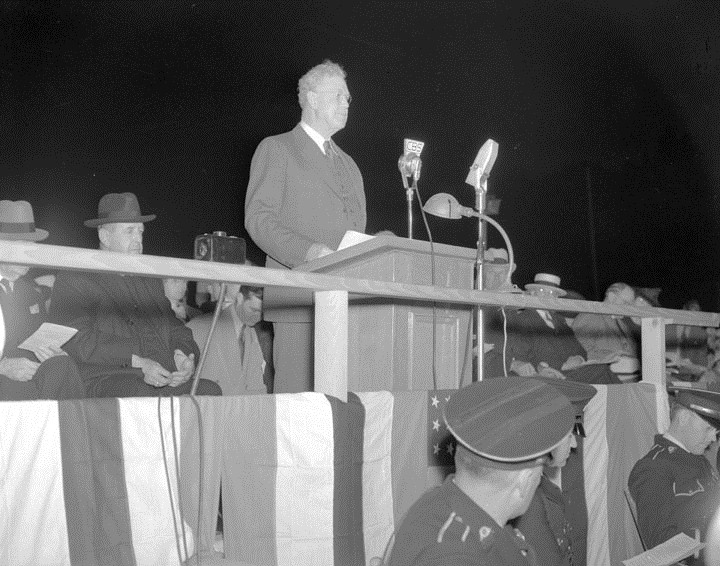 |
|
| (August 1, 1940)* - H. A. Van Norman speaking at the dedication of the Mulholland Memorial. |
LADWP Historic Archive
August 1940 – Witnessed by a large crowd that included prominent civic leaders who were old time friends; Department employees who were associated with him when he was building the Owens River Aqueduct; and hundreds of people who knew him only as “father of the City water system,” the William Mulholland Memorial was dedicated the night of August 1, 1940.
The impressive dedicatory ceremonies opened with selections by the Los Angeles Police Band, under the direction of Captain Harry Signor. Following brief introductory remarks by George Sopp, secretary of the Memorial Engineering and Construction committee, Aqueduct Post Color Guard presented the flag of our country and led in the pledge of allegiance. Mass singing of the National Anthem was led by the Los Angeles Civic Chorus, directed by J. Arthur Lewis.
After the invocation by The Most Reverend John J. Cantwell, Mr. Sopp introduced Joseph Scott, chairman of the Memorial Committee, and master of ceremonies for the evening. Mr. Scott, in turn, introduced other Committee members, and Walter S. Claberg, designer of the Memorial.
Heading the list of prominent speakers, each of whom spoke on a particular phase of Williams Mulholland’s character, was Watt L. Moreland, president of the Board of Water and Power Commissioners. His subject was “William Mulholland’s Accomplishments.”
T. B. Cosgrove spoke of Mulholland’s prophetic vision and was followed by W. P. Whitsett who reminisced on “Then – and Now.” Tribute to Mulholland’s engineering genius was paid by a long time associate, J. B. Lippincott. “Mulholland the Planner” brought glowing praise from E. F. Scattergood and “There It Is – Take It,” by Harry Chandler, told of another dedication – that of the arrival here in 1913 of the first water to flow through the 238 mile length of the Aqueduct.
Vierling Kersey and Victor H. Rossetti presented messages that dealt with the educational and business aspects of Mulholland’s life.
The personal side of Mulholland, the friend, was related with interesting anecdotes by Henry W. O’Melveny. Final tribute fittingly was paid by H. A. Van Norman, Water Bureau head, who, speaking as an employee of the Department of Water and Power chose as his subject “William Mulholland, The Chief.”
Interspersed between speakers were musical numbers by the Civic Chorus and Douglas McPhail, young singing star from Metro-Goldwyn-Mayer.
To Patricia Mulholland, nine-year-old granddaughter of the beloved Chief, went the honor of pressing the button which brought to life the illuminated fountain and officially placed it in operation.
After emphasizing the inspirational value of Mulholland’s life in well chosen remarks. Mr. Scott presented the Memorial to the citizens of Los Angeles, the acceptance speech being made by Mayor Fletcher Bowron.
Following mass singing of “America,” the program was brought to a close with the benediction by Dr. William Martin, pastor of Wilshire Methodist Episcopal Church.
As epitomized by Mr. Van Norman, the memory of William Mulholland – The Builder is indelibly impressed on the minds of Los Angeles citizens by outstanding accomplishments – building of the Owens River Aqueduct and development of the City’s water system which has grown to the second largest distribution network in the United States.
And with the dedication of the Memorial, the memory of Williams Mulholland – The Man, will be perpetuated.
Distinguished by lack of any ornate details, the Spartan simplicity of the Memorial’s design typifies the rugged, honest, straightforward character of the beloved Chief.
His innate kindness, which he attempted to hide under an outer covering of gruffness, is brought out by gently cascading jets of water, brought to beautifully life by softly subdued lights of many colors.
The Memorial not only is a tribute to Mulholland; it is a tribute to an appreciative citizenry, from civic leader to laborer, from pioneer resident to school child, whose dollars, dives and pennies made possible its construction.^
.jpg) |
|
| William Mulholland Memorial Dedication - Patricia Mulholland, nine-year old granddaughter of the beloved Chief, had the honor of pressing the button which brought to life the illuminated fountain and officially placed it in operation.* |
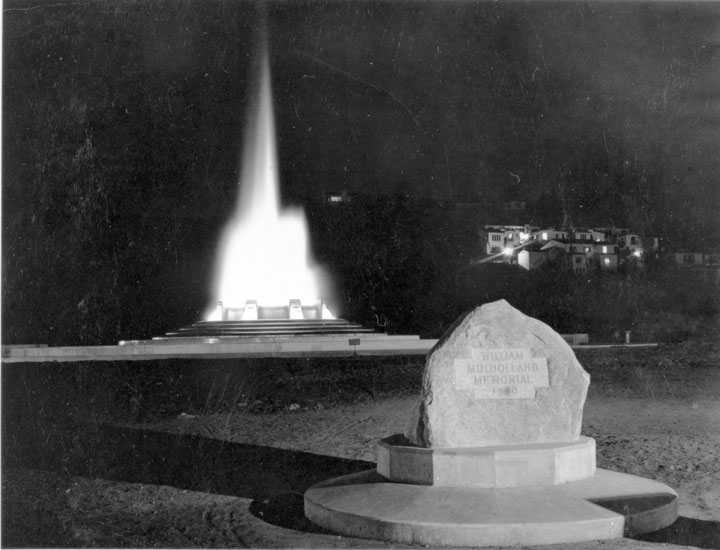 |
|
| (1940)* - Wiliam Mulholland Memorial - Night shot shows illumination. |
Historical Notes In the main approach to the fountain memorial, a five-ton granite boulder that symbolizes the rugged character of William Mulholland has been placed. It was brought down from the hills above Haiwee Reservoir, where Mulholland saw it while the aqueduct was under construction and commented upon its pink beauty. Little could be visualize that more than a quarter century later it would be part of a memorial erected in his honor. But H. A. Van Norman, who was with him when he dropped the comment, did not forget. When the time came that a memorial was to be built, his suggestion that the granite boulder from Haiwee be used for the memorial inscription and to receive the documents that are to be permanently preserved was enthusiastically approved.^ The inscription reads as follows: |
|
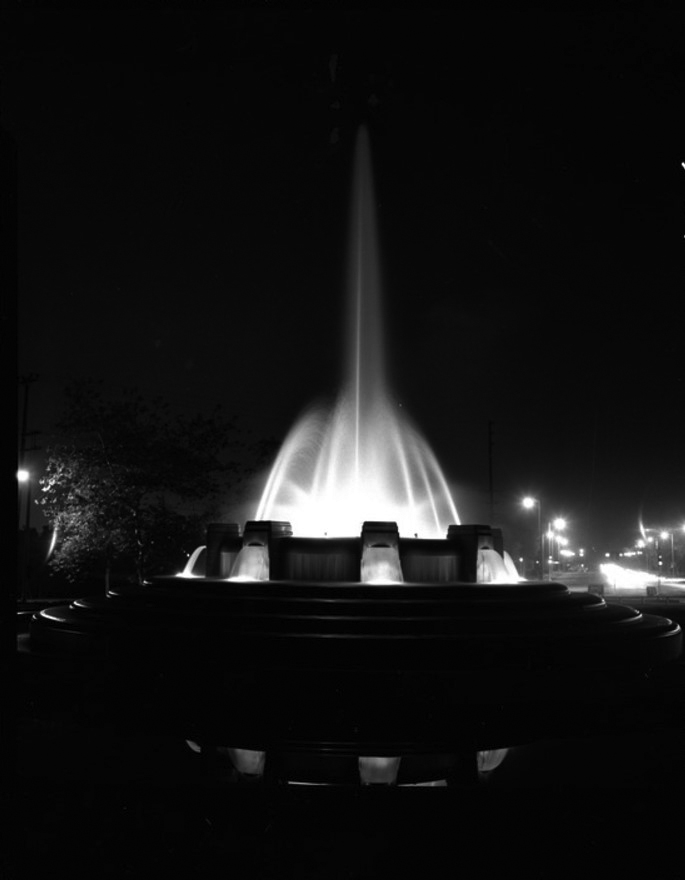 |
|
| (1955)^^^ – Close-up night view showing the William Mulholland Memorial Fountain. |
Historical Notes The above photo comes from a 1955 article in the LA Times called Know Your City. The caption read: It’s the city's most colorful fountain, the memorial to William Mulholland, "father" of Los Angeles' water supply. Located at Riverside Drive and Los Feliz Blvd., the fountain's changing sprays are dramatically illuminated with varying colored lights. It was dedicated on 1940. And, yes as a boy, Mulholland lived in a ramshackle farm on this. After occasional forced periods of dormancy (either because of oil rationing or droughts), the electrified fountain eventually fell into disrepair – but its mechanisms were reconstructed and the fountain was rededicated in 1996. It now lights up gloriously and colorfully at night. |
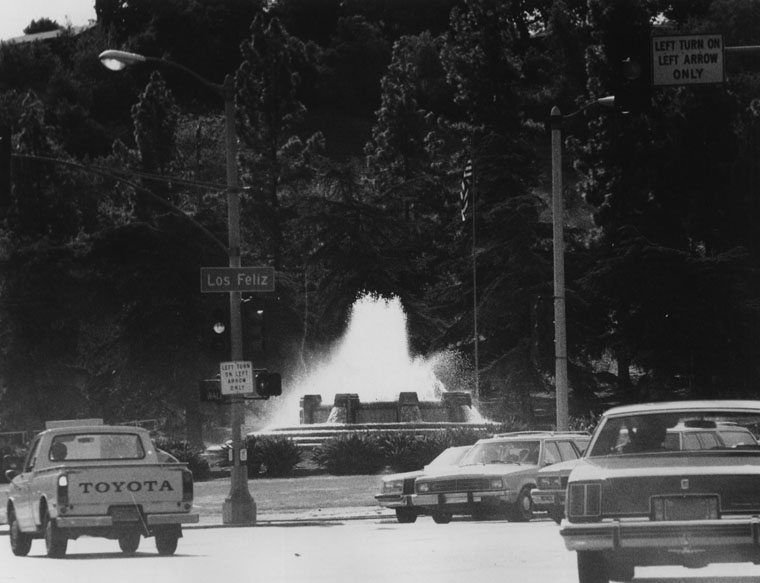 |
|
| (ca. 1980s)* - The Mulholland Fountain on the corner of Los Feliz Blvd. and Riverside Drive. Designed by Walter S. Clayberg in 1940. Photographer: Tom LaBonge |
Historical Notes In 1976 the Mulholland Fountain was declared City of Los Angeles Historic-Cultural Monument No. 162. |
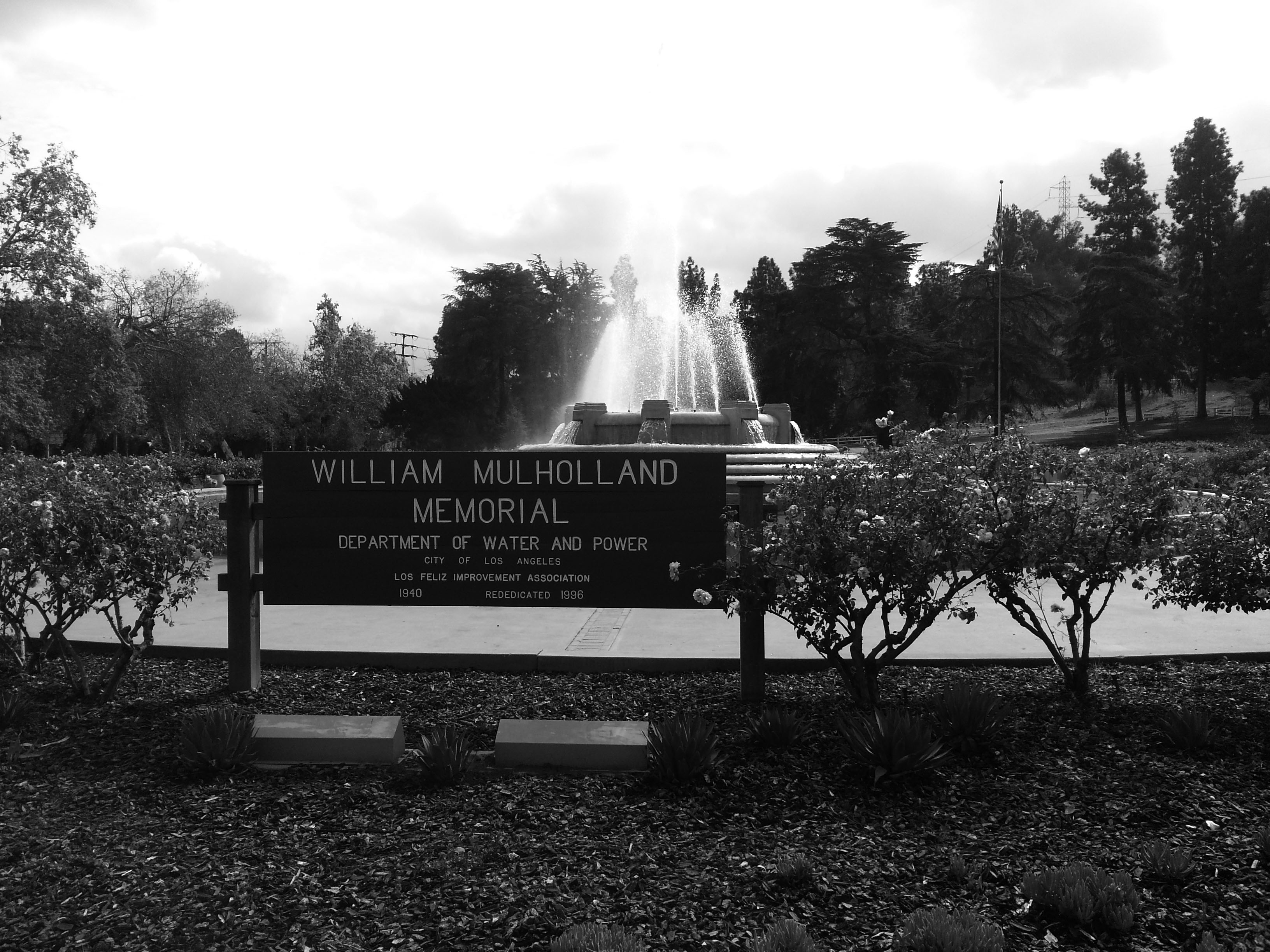 |
|
| (2014)*^* - View of the sign in front of the William Mulholland Memorial and Fountain. The sign reads: William Mulholland Memorial, Department of Water and Power, City of Los Angeles, Los Feliz Improvement Association 1940, Rededicated 1996. Photo by Water and Power Associates. |
Historical Notes The park that surrounds the fountain, the Los Angeles Aqueduct Centennial Garden, was built by LADWP crews in conjunction with the centennial celebration of the Los Angeles Aqueduct in 2013. A walking path recreates the aqueduct’s 340-mile journey from the Eastern Sierra Nevada Mountains to L.A.’s San Fernando Valley, terminating at a replica of The Cascades. The commemorative garden also features a section of the original aqueduct pipe, 10 feet in diameter, water-wise landscaping and a bronze bas-relief portrait of Mulholland by Grace Banks Eldridge that was added in 1959. |
.jpg) |
|
| (2014)*^* - View of the William Mulholland Memorial Fountain through a pipe section of the Los Angeles Aqueduct. Photo by Water and Power Associates. |
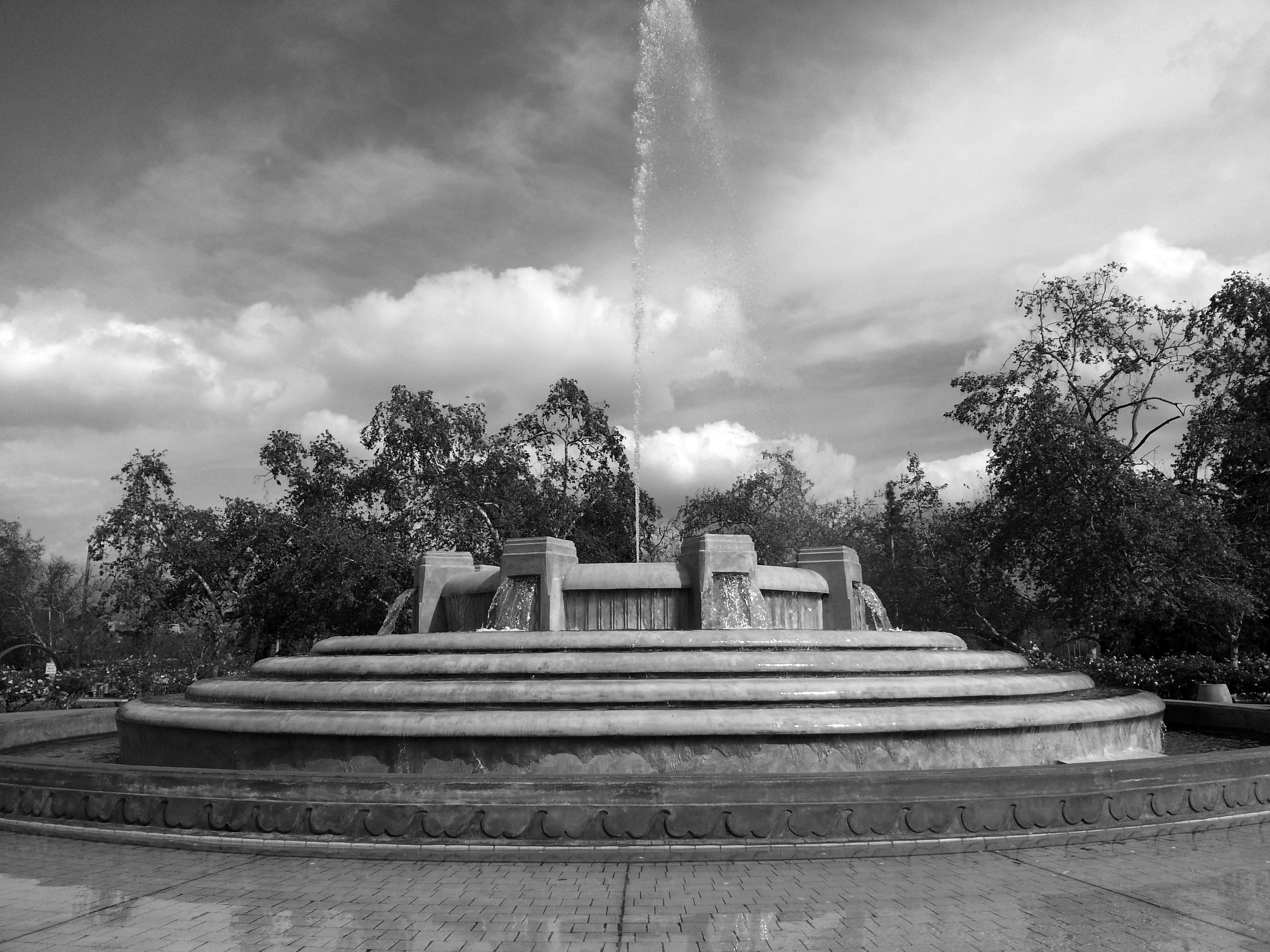 |
|
| (2014)*^* - Close-up view of the William Mulholland Memorial Fountain at the corner of Los Feliz Boulevard and Riverside Drive. In November of 2013, the memorial fountain was rededicated at the celebration marking the 100 year anniversary of the opening of the Los Angeles Aqueduct (Click HERE to see more in Opening of the LA Aqueduct). |
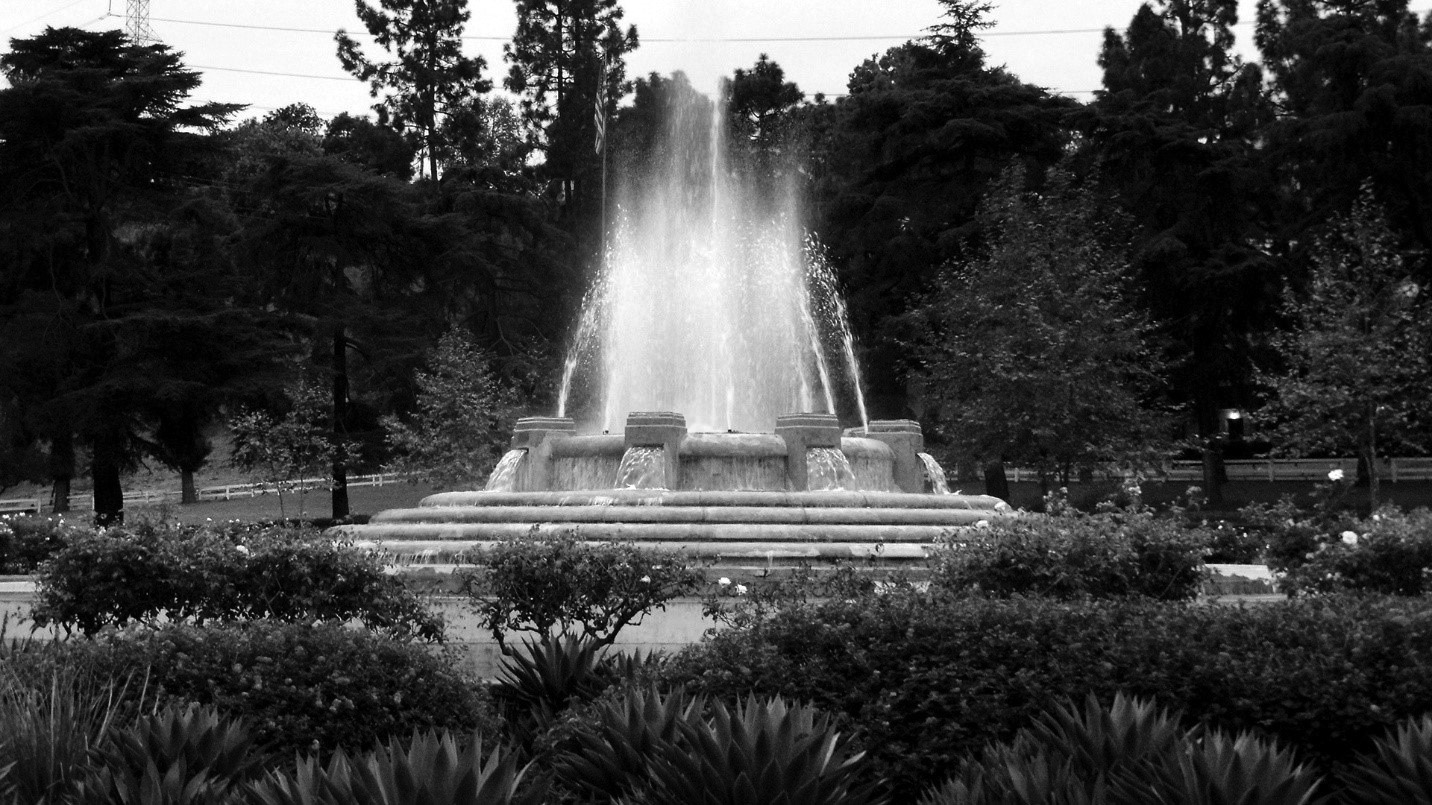 |
|
| (2020)^.^ - View showing the Mulholland Fountain as it appears today, located at the corner of Riverside Drive and Los Feliz Boulevard in Los Feliz…..”A spitting distance from the Los Angeles River”. |
Mulholland Dam
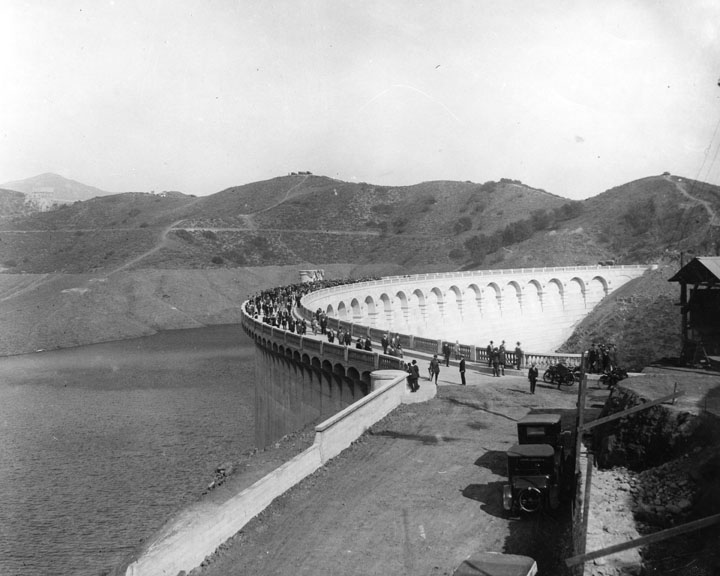 |
|
| (1925)* - Hollywood Reservoir and Mulholland Dam are shown with a crowd walking across the dam during the dedication ceremony. An American flag can be seen draped over one of the towers. |
Historical Notes The Mulholland Dam was a concrete-arched gravity dam built as a large reservoir in the Hollywood Hills. The dam was built between August 1923 and December 1924 under the supervision of William Mulholland, chief engineer for the City of Los Angeles Bureau of Water Works and Supply. The reservoir formed behind the dam was called the Hollywood Reservoir (later Lake Hollywood) and would hold up to 2.5 billion gallons of water from the Owens River Aqueduct System (LA Aqueduct) and from the groundwater of the San Fernando Valley. |
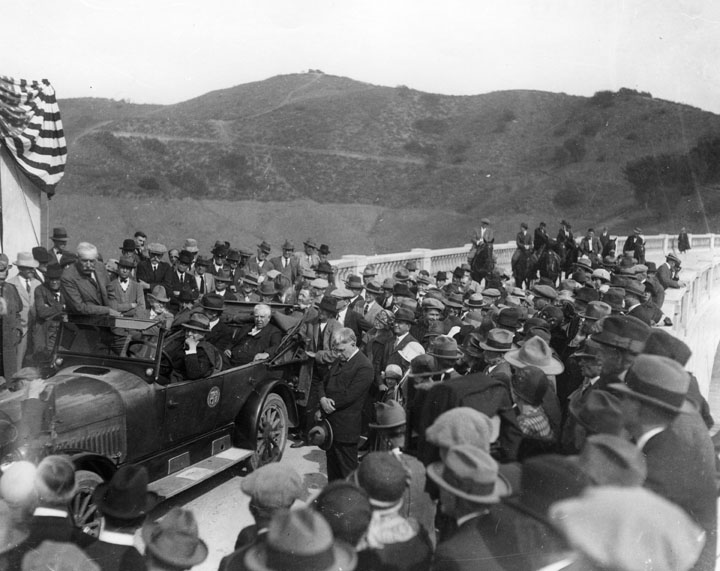 |
|
| (1925)* - Hollywood Reservoir and Mulholland Dam during dedication ceremonies. William Mulholland is shown standing in the car. To the rear are several riders on horseback. |
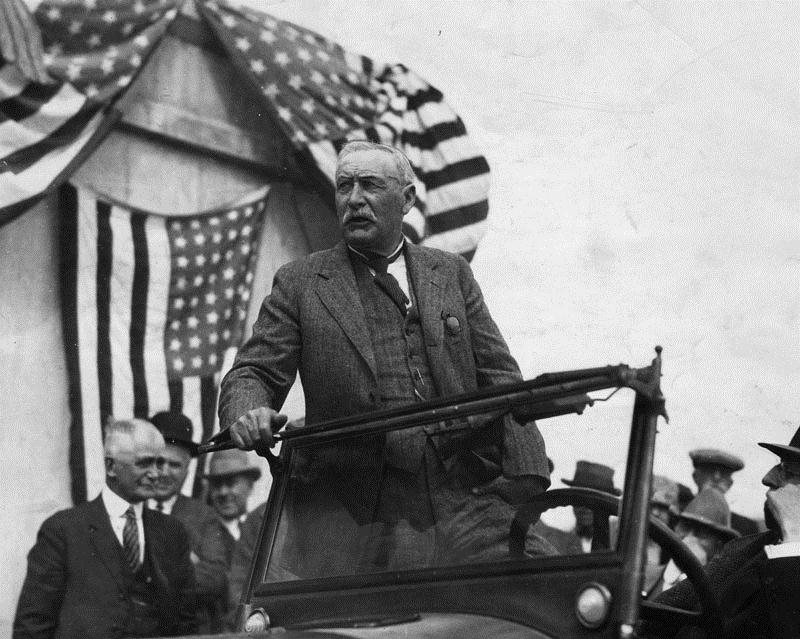 |
|
| (1925)* - William Mulholland standing in an open automobile in front of American flags at the dedication of the Mulholland Dam and Hollywood Reservoir. Click HERE to see the William Mulholland Biography. |
Historical Notes Coincidence? Dedication ceremonies for the Mulholland Dam were held on St. Patrick’s Day, Tuesday, March 17, 1925. And, of course, William Mullholland was Irish (born in Belfast, Ireland, on September 11, 1855). |
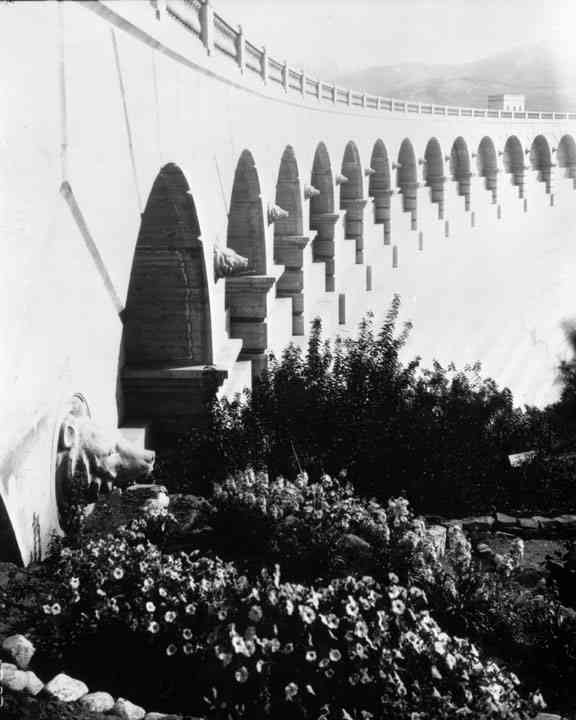 |
|
| (1925)* - Caption reads: Graceful arches and landscaping make Hollywood Dam an object of beauty as well as of service in providing a valuable reserve water supply for Hollywood and other districts of Los Angeles. |
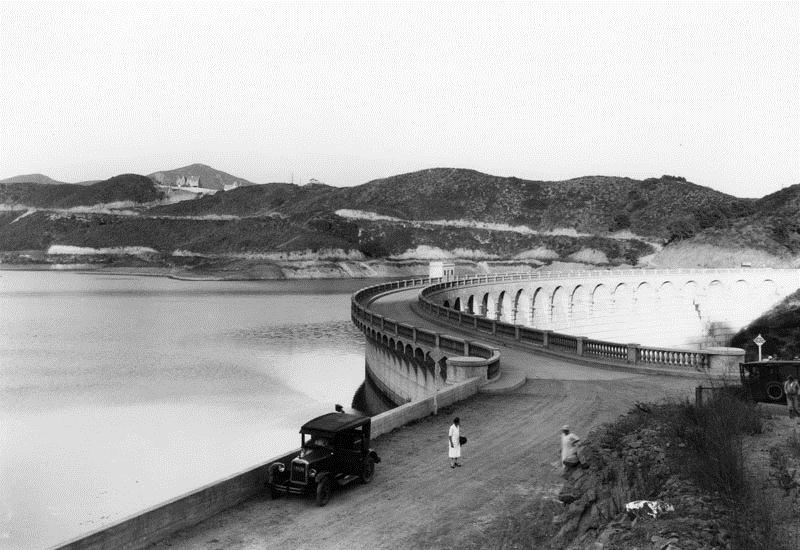 |
|
| (1928)* - View of Mulholland Dam and Hollywood Reservoir (also known as Lake Hollywood) both designed and built by engineer William Mulholland, for which the Dam is named after. |
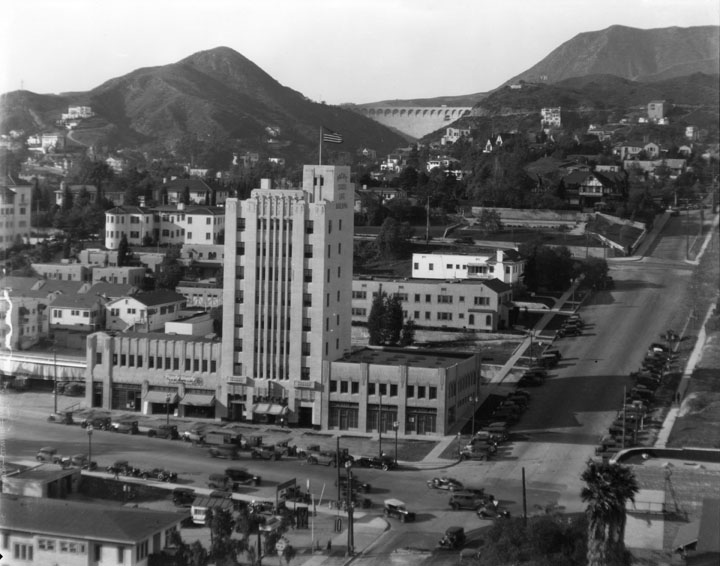 |
|
| (1928)** - View looking north from over the intersection of Yucca and Vine streets, showing the Hollywood Dam straddling the Hollywood Hils canyon. The Art Deco style Mountain States Building (now Yucca Vine Tower) is seen in the foreground. |
Click HERE to see more in Mulholland Dam and Hollywood Reservoir |
Mulholland Highway
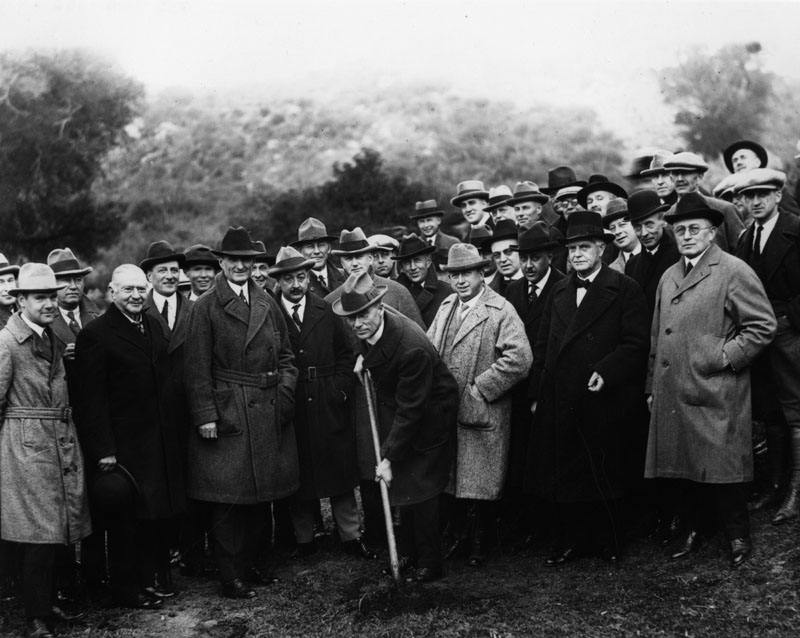 |
|
| (1923)* - Groundbreaking ceremony for Mulholland Drive, named for William Mulholland. |
Historical Notes This winding ridgeline road in the Santa Monica Mountains was dedicated in honor of William Mulholland, the water engineer who designed the Los Angeles Aqueduct, on Dec. 27, 1924. Originally dirt and called Mulholland Highway, the name was changed to Mulholland Drive in 1939. Portions of the original road remain unpaved.^* |
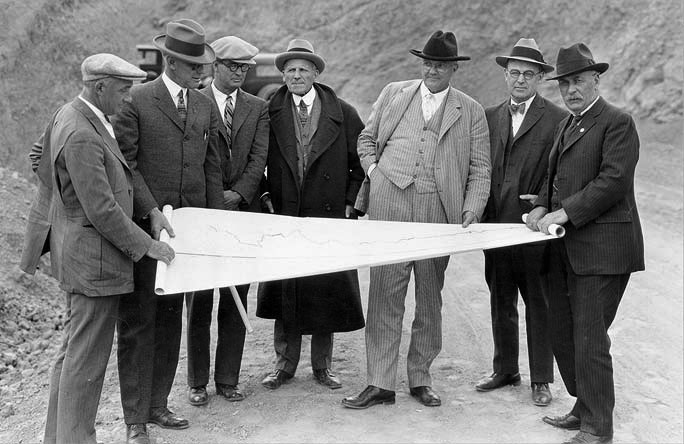 |
|
| (ca. 1923)*^ - A group of men survey Mulholland Drive. Moses Sherman is at center with Harry Chandler to the right of him. William Mulholland is on the far right. |
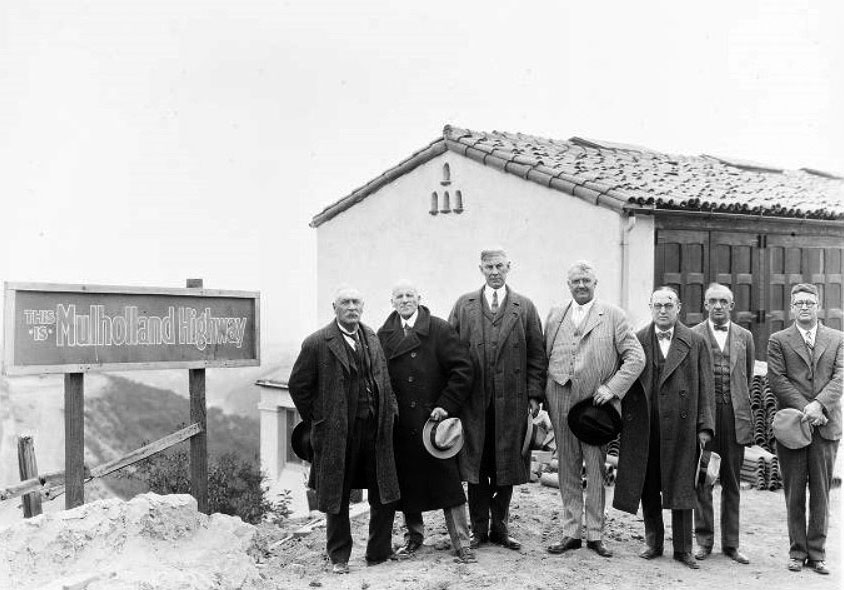 |
|
| (1920s)*^ - William Mulholland (far left), Moses Sherman (2nd from left), Harry Chandler (center) and a group of men posing next to a "Mulholland Highway" sign while out examining the Mulholland Dam site. |
Historical Notes The house you see in the background still exists today and is below the Hollywood Sign. Click HERE for contemporary view. |
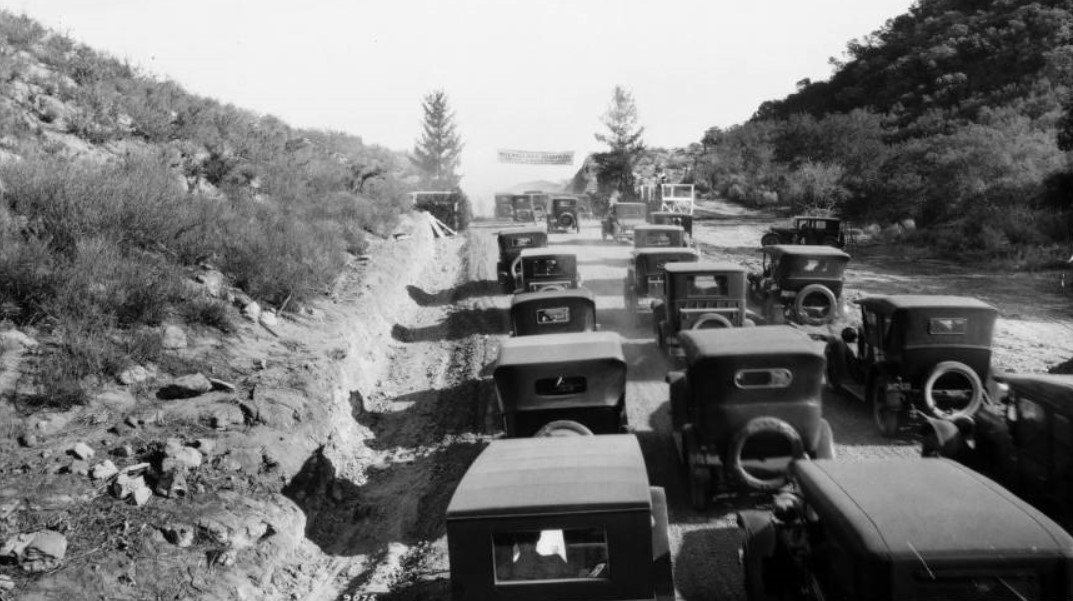 |
|
| (1924)^^ - View of over a dozen early model cars clustered at the opening of the Mulholland Highway. Three rows of early automobiles make their way up the hill and through the mountains on the Mulholland Highway. Rocks and scrub vegetation cover the slopes to either side, a parked car and a wooden platform visible to the right, just off the road. At the peak of the hill, a banner is hung between two trees. |
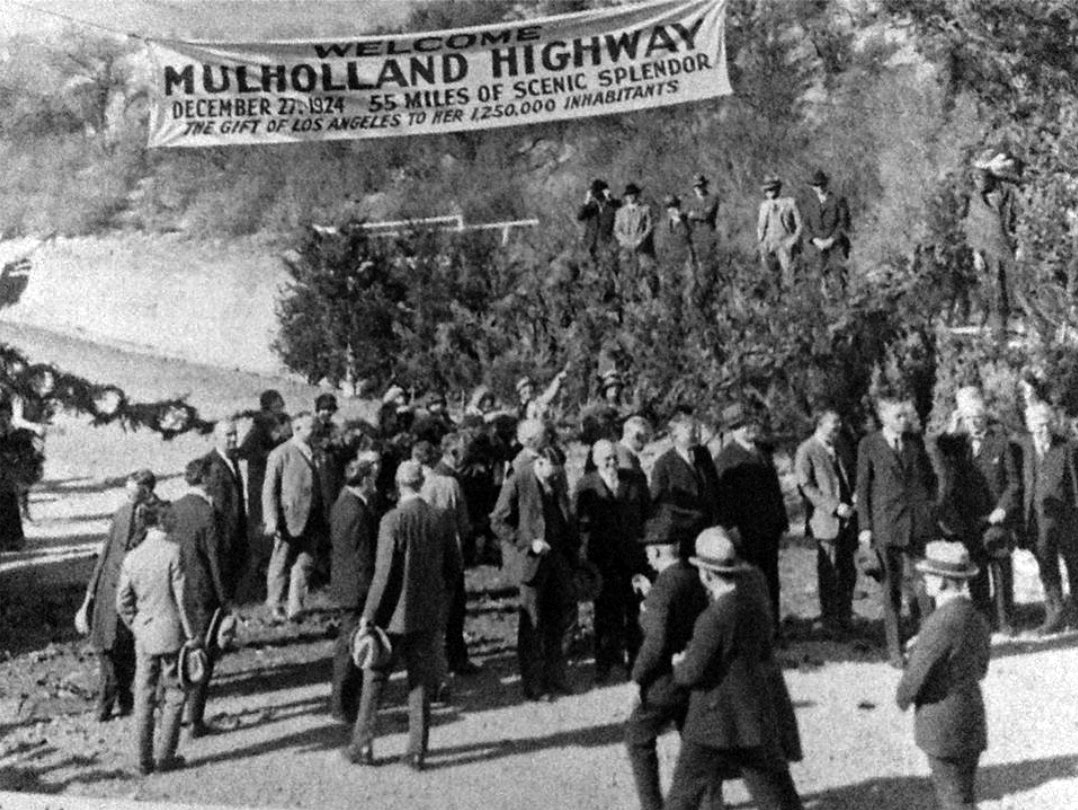 |
|
| (1924)^*^ – Closer view showing dignitaries assembling near a banner which reads: Welcome Mulholland Highway - December 27, 1924 – 55 Miles of Scenic Splendor – The Gift of Los Angeles to her 1,250,000 Inhabitants |
Historical Notes On the morning of the opening (Dec 27), William Mullholland dedicated the road with, what else, a bottle of aqueduct water. (Being prohibition, he couldn't use champagne). #^ |
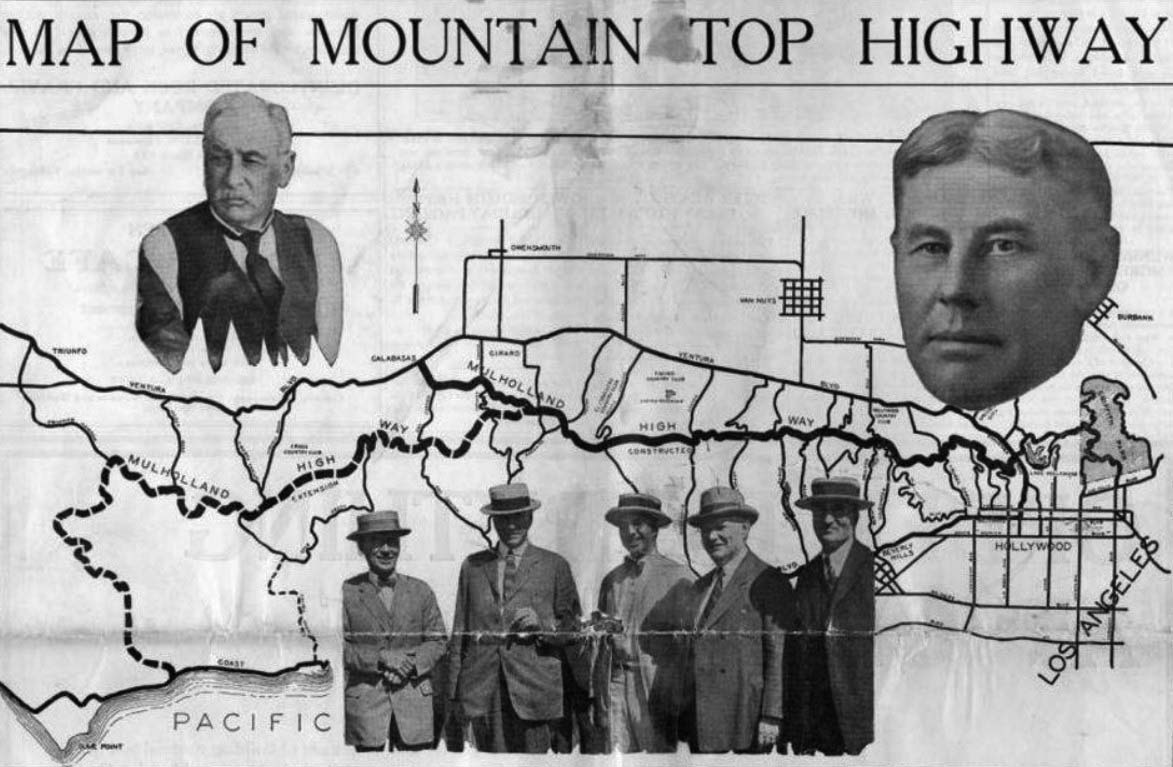 |
|
| (1924)#^ – Map of the Mulholland Highway when first opened. Girard News |
Historical Notes At the opening, Mullholland was 24 miles long - the solid line, running from Cahuenga Pass to Calabasas. The dotted line shows what was still to be constructed, Topanga Summit to the Ocean. Originally the road was of gravel surface treated with oil. |
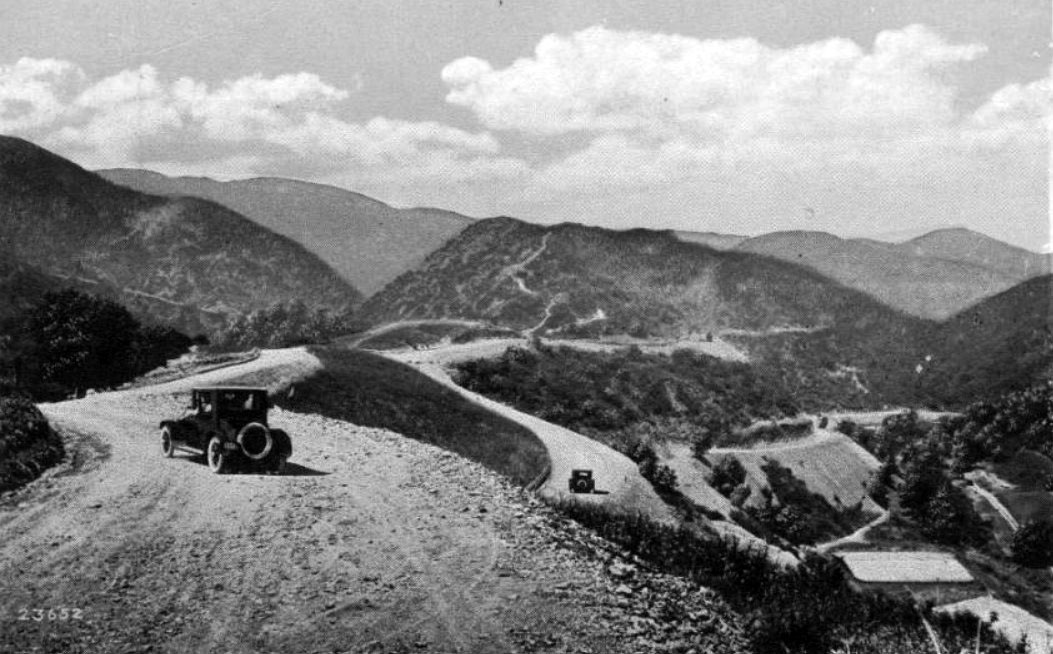 |
|
| (ca. 1924)^# – Postcard view showing two early model cars near the intersection of Mulholland Highway (later Drive) and Franklin Canyon. |
Historical Notes Curving ingeniously through the eastern Santa Monicas, the Mulholland Drive motorway once brought a heavy slew of Angelenos into the Valley. In the early 1970s, however, 5,000 local activists successfully prevented the cement paving of most of that stretch. To this day, that section is known as 'Dirt Mulholland', and is only open to cyclists and pedestrians. From the famous Mulholland Bridge east, Mulholland Drive completes its creator's vision, and winds through the affluent Hollywood Hills to Mulholland Drive's easternmost terminus at Cahuenga Boulevard, near Universal Studios, until again becoming an unpaved footpath to Griffith Park.*^ |
 |
|
| (ca. 1938)** - This view of a Mulholland Highway directional sign, which is attributed to the Automobile Club and includes an AAA logo, is taken from the Cahuenga Pass where Cahuenga meets Mulholland. The natural hillside is visible to the east because this is before the 101 freeway was built. The name of the road would be changed to Mulholland Drive in 1939. |
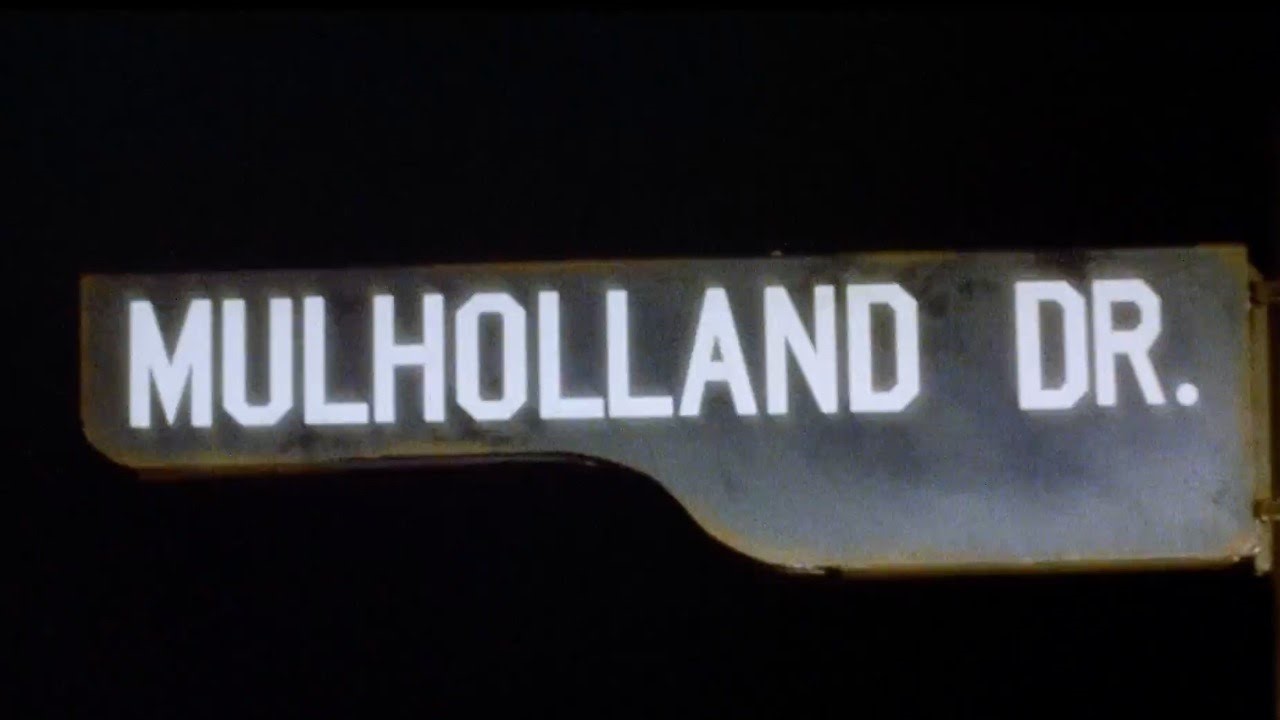 |
|
| Mulholland Highway was renamed Mulholland Drive in 1939. |
Listing of Mulholland Monuments
◆ Mulholland Dam in the Hollywood Hills (1925) ◆ Mulholland Pump Station, located below the dam at the intersection of San Marco Drive and Holly Drive (still in service) ◆ Mulholland Tank, located just past the end of Creston Drive, NE of the pump station ◆ Mulholland Highway (1924) ◆ Mulholland Drive (1939) ◆ WWII Liberty Ship SS William Mulholland, hull #677, launched December 1942 (scrapped in 1962) ◆ Mulholland Middle School, located at 17120 Vanowen Street, Lake Balboa, in the San Fernando Valley |
Other Mulholland Tributes and Honorariums
In 1914, the University of California at Berkeley honored Mullholland with an honorary doctorate degree. The inscription on the diploma read, "Percussit saxa et duxit flumina ad terram sitientum" (He broke the rocks and brought the river to the thirsty land). Mulholland's public profile continued to grow. His offices were, at one point, on the top floor of Sid Grauman's Million Dollar Theater. He was even a favorite to become mayor of Los Angeles. However when asked if he was considering running for office he replied, "I'd rather give birth to a porcupine backward". Mulholland's stature was also recognized internationally: he provided technical assistance during the construction of the Panama Canal.*# |
Girard News Tribute
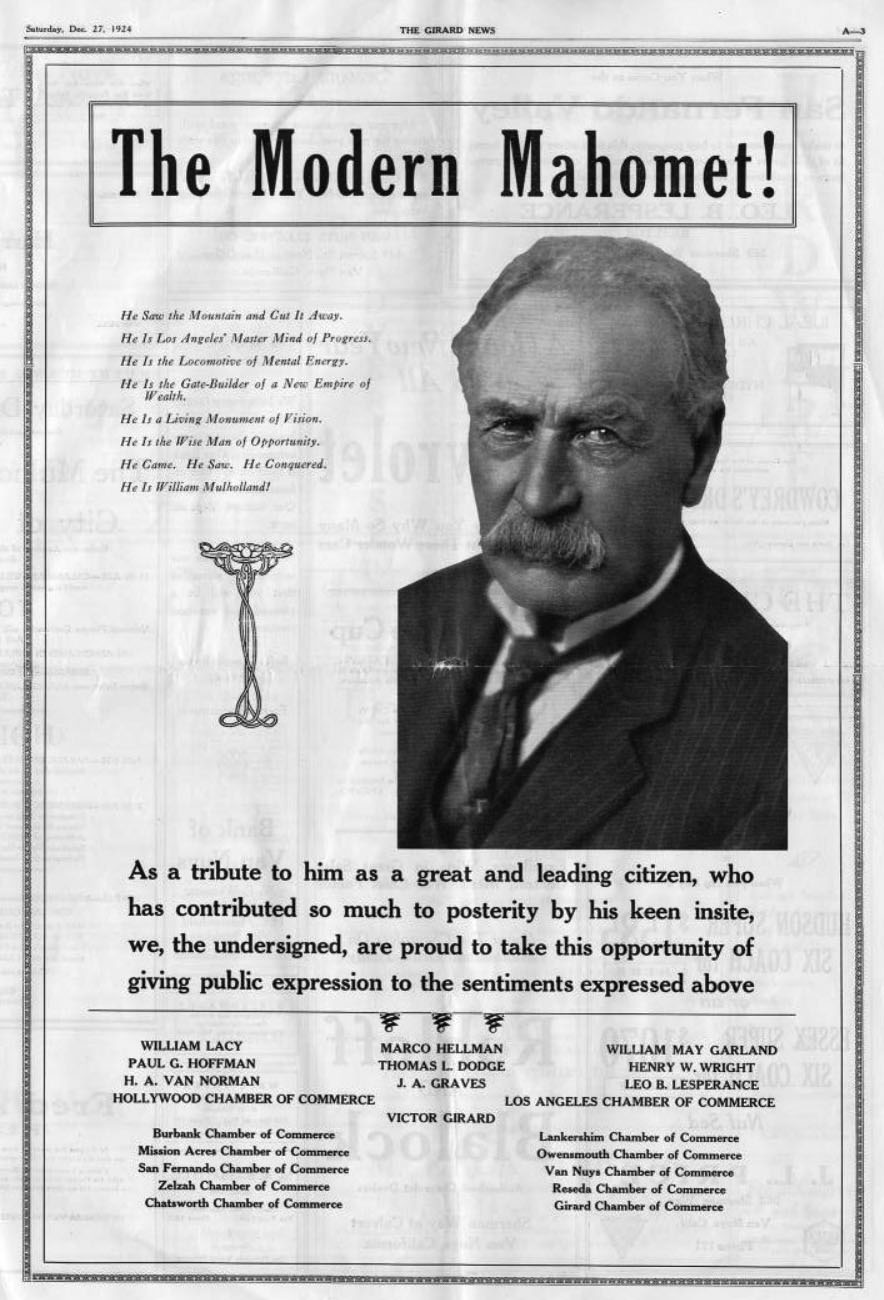 |
||
| (1924)#* - Page A-3 of the Girard News, Vol. 3, No. 17, Saturday December 27, 1924. Features a tribute to William Mulholland from leading members of the San Fernando Valley. |
Historical Notes Newspaper tribute reads: As a tribute to him as a great and leading citizen, who has contributed so much to posterity by his keen insite, we the undersigned, are proud to take this opportunity of giving public expression to the sentiments express above. He Saw the Mountain and Cut It Away. The Girard News was published in Girard (later renamed Woodland Hills) and served the communities of San Fernando, Van Nuys, Lankershim, Reseda, Owensmouth, Chatsworth, Rio Vista, Villa Vista, Pacoima, Zelzah, Weeks Colony, and other areas. This is page 3 of an 8-page section. Newspaper. |
Mulholland Plaque
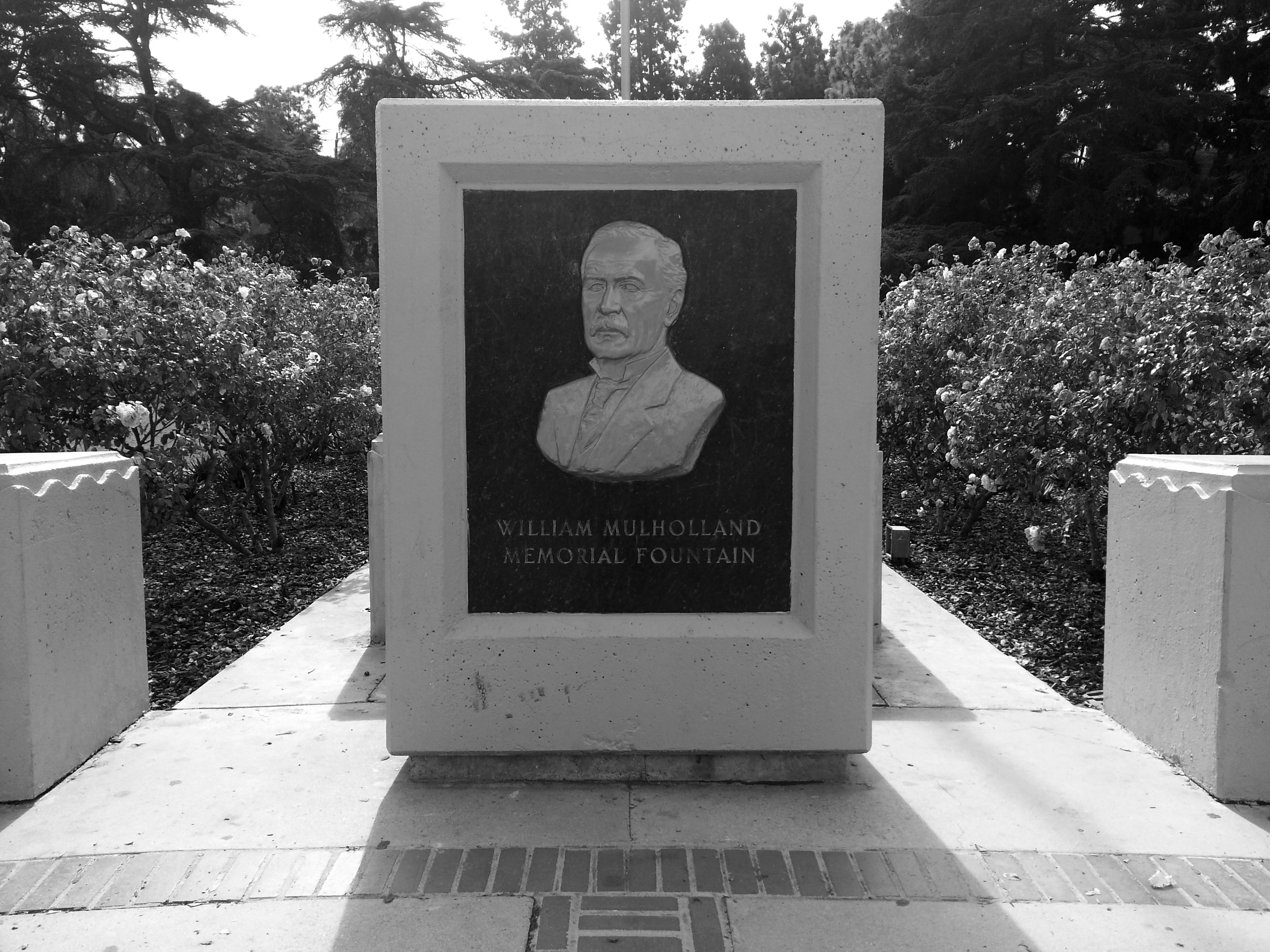 |
|
| (2014)*^* - View of plaque in front of the William Mulholland Memorial Fountain located at the corner of Los Feliz Blvd. and Riverside Drive. Photo by Water and Power Associates. |
Click HERE to see Construction of the LA Aqueduct |
* * * * * |
History of Water and Electricity in Los Angeles
More Historical Early Views
Newest Additions
Early LA Buildings and City Views
* * * * * |
References and Credits
* DWP - LA Public Library Image Archive
**LA Public Library Image Archive
*^Huntington Digital Library Archive
^*The Valley Observed - Street Name Origins
^#Calisphere: University of California Image Archive
#^Facebook.com: West San Fernando Valley Then And Now
*# Wikipedia - William Mulholland; Mulholland Drive/Highway
#*CSUN Oviatt Library Digital Archives
**^Boston Public Library: Flickr.com
^^^UCLA Library Digital Collection
^*^Facebook.com - Bizarre Los Angeles
< Back
Menu
- Home
- Mission
- Museum
- Mulholland Service Award
- Major Efforts
- Board Officers and Directors
- Positions on Owens Valley and the City of Los Angeles Issues
- Legislative Positions on
Water Issues
- Legislative Positions on
Energy Issues
- Recent Newsletters
- Historical Op Ed Pieces
- Membership
- Contact Us
- Search Index